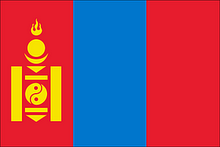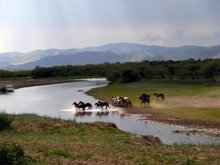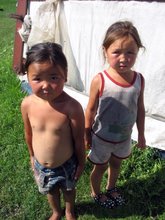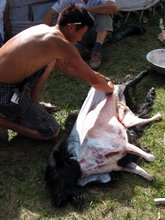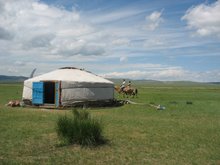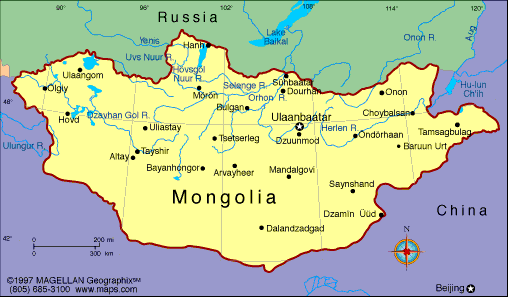- Please describe your biggest challenge during the past six months.
One of my biggest challenges was trying to implement the Peace Corps' primary goal of Capacity Building through trainings for CPs; it was like pulling teeth. As a non-profit that worked with vulnerable children that receives its funding through monetary and material donations from foreign organizations, it seemed to me that if a project idea did not have an immediate end result of a physical gain (i.e. money or material goods), then they were not interested in the training. Learning a new skills set (i.e. learning English or how to start up a small business), in which the end result was applying the new skill on your own, had no takers at this HCA. Maybe the reason lay in the type of agency or because of their lack of exposure to training and its benefits (as compared to a formal school where trainings are setup by the local Education Center) that was the cause of their lack interest.
Secondly, I did not really having a counterpart to work side by side with on projects. My only English-speaking CP, like most of my CPs, had a totally different job responsibility and work schedule than myself. My CPs are orphanage caretakers that worked a full day schedule plus a rotated a two overnight stay per week at the orphanage Mon-Sat while I worked a 9am-5pm workweek Mon-Fri. Thus, it was hard to coordinate time to work on projects together. She was merely my glorified translator.
- Over the past six months what have you done, or what ideas have you generated, to promote a better understanding of Mongolians on the part of Americans, both during and upon completion of your service? (Peace Corps' Goal 3)
I hope my daily interaction with my CPs and children have caused them to understand not only me but also my Western mindset and my "American" ways of approaching projects (e.g. potluck community meetings in my home, researching information through the internet, networking through meeting new people through people you already know) and teaching/training methods. Socially, I have invited my CPs over to my home for dinners and conversation (broken Mongolian combines with hand gestures and animated facial expressions goes a long ways). I have found that the key to quickly getting projects accomplished and ideas across is if you first build a personal connection with the people you are trying to work with.
- If you left Peace Corps tomorrow, what would you miss most about living and working in Mongolia?
I would miss the ancient monasteries and the landscape; being struck in awe at the magnificent of beauty in the rock formations, the endless blue sky, the rolling hills, the high mountains, the winding rivers, and the peacefulness of it all. Mongolia is so unique in its nomadic (aka: simple) way of living; I would miss that also. And I would miss my children dearly.
What I wouldn't miss is the daily smell of urine in my stairwell, the backup pipes in my poorly made Russian building that gives off a putrid smell, the careless littering combined with lack of an organized government trash pickup system, and the very, very packed meekers in an 8+ hour dirt road trip.
Burengiin Nuruu Mountain Range

History of the Peace Corps Program in Mongolia
Country Assignment
- Country: Mongolia (Outter)
- Program: Youth Development
- Job Title: Life Skills Trainer (also: English teacher, Child Caretaker, Fund Raiser, Events Organizer, and IT Trainer)
- Orientation (Staging in Atlanta, GA): May 31-June 2, 2007
- Pre-Service Training (in Darkhan and Sukhbaatar, Mongolia): June 3-August 18, 2007
- Dates of Service (in Darkhan at Sun Children formerly "Asian Child Foundation" - a non-profit, non-government Japanese funded orphanage of 37 Mongolian children opened since 8/25/2005): August 19, 2007- August 18, 2009
Location and Nature of the Job
CYD Volunteers are placed in provincial centers with population between 15,000 and 70,000. A few CYD Volunteers are placed in Ulaanbaatar, where the population is reaching 1 million. I will work with youth-focused NGOs, children’s centers, schools, and civil society organizations to address major challenges confronting Mongolian youth today, such as education, life skills, employability, and leadership. In addition, the work will involve workshops and presentations at schools and community agencies and will entail traveling to other outlying communities that have less access to information and training. Given the vast distances in Mongolia, these visits will often require overnight stays.
Wednesday, April 16, 2008
Questions from the Bi-Yearly Peace Corps Progress Report Questionnaire
Monday, April 7, 2008
Agency's Participation in Global Youth Service Day 2008: Youth Sports Tournment Weekend (Darkhan Community)
Organization
Sun Children (formerly, “Asian Child Foundation”)
Description
The orphanage was in desperate need of a fitness facility. The only thing it already had was an old basketball court with broken hoops and an empty backyard. Not so much as an inflated ball. The youth expressed this need to the Agency’s staff members back in September 2007. Sports instill a sense of camaraderie and self esteem. It transcends the cultural, language, and age barriers that inhibit communication. Prior knowledge of the rules of the game are not need to play and participate, one only has to observe. In addition, sports and fitness advertises a healthy body image. Thus, we, as an Agency, felt this idea was an excellent one. With the help of the United States Marine Humanitarian Civil Action program in conjunction with the US Embassy in Mongolia and the 330th Mongolian Army (based in Darkhan), the orphanage received financial and labor assistance to renovate the existing basketball court, build a volleyball court, and soccer goals; the funding for materials and the purchase of the materials took place in October 2007, while the building of the sports field was in late November 2007. Continuing with their goal, the youth gutted out an unused second kitchen in one of the three buildings on the orphanage compound to build a fitness room/gym; the planning and labor of this phase took place in December 2007.
For the third and final phase of our project, youth will host a “Sports Tournament” weekend during GYSD on the weekend of April 26-27, 2008. Between the months of February to April, youth will assist in the planning of this day that will include have meetings to determine additional subjects/topics for classes/presentations during GYSD, make invitation flyers to pass out to their fellow classmates (in their respective schools in the community), speak to local area business for support and donations (i.e. refreshments, tournament prizes, additional community member volunteers), and advise the GYSD event (e.g. making a radio advisement announcement). The already determined classes/presentations are:
• Trafficking in Persons (TIP) in Mongolia
• Environmental Conservation (pollution base; air pollution and littering)
• Fitness/Healthy Exercises
• Art and crafts projects; uses of recyclable items (i.e. plastic bottles, bottle caps, shards of broken glass, aluminum cans, cardboard boxes)
We anticipate 37 additional children from the community in addition to our youths making the total amount of participants to 74 youth ages 11-18 and 18 older youth and adult volunteers. The above listed classes/presentation topics will be given by 6 of these older youth and adult volunteers. Leading up to the weekend of GYSD, youth will participate in all areas of preparation including the setup of rooms for classes/presentations, food preparations, and opening and closing ceremonies.
Date/Time
April 26, 2008 at 11am-5pm
Location
Sun Children's Orphanage
Darkhan (New), Mongolia
Mongolia
RSVP Information
Name: Yoomie Huynh
Phone: + (976) 957-423-48
E-mail: yoomiehuynh@gmail.com
Tuesday, April 1, 2008
Article: What is a Peace Corps Volunteer Worth?
By Jim Carl, Peace Corps-Mongolia Country Director in the Peace Corps Mongolia Monthly Memo, April 2008 edition
Or more precisely, what does a PCV cost? Last month, President Bush submitted his budget request for fiscal year 2009 which included $343.5 million for Peace Corps. Where does all that money go? I did an easy calculation; if you take the current year's budget ($331 million) and divide it by the average number of PCVs in the field (8,100) you realize that for every PCV, American taxpayers are shelling out about $40,000 per year…
…By now I imagine you are looking at your lasts [monthly] living allowance (127,000T/about $109) and the figure $40,000 and shaking your head in disbelief or at least trying to figure out why you're not getting a bigger piece of the pie. But the truth is, you are really getting most of the pie.
…You receive about $4,500 per year including living allowance, leave allowance, readjustment allowance, and pro-rated part of your settling-in allowance. And housing and utility costs, that average[s] about $125/mo or $1,500 per year. So that's $6,000 easy but what about the other $34,000?
To get you into the country and back home again with a little extra added to cover the few who get special leave or emergency leave is another $4,000 ($2,000 per year). And then there is health, which sets us back about $4,000 per year per PCV. This includes the occasional medical evacuation; at less than $350 per mo is real bargain for 100% coverage that includes prescriptions, vision and dental care.
Remember the recruiter that you spoke to occasionally…when you were joining Peace Corps? Well, it cost about $6,000 per PCV ($3,000 per year) for 2 years of service to get you recruited. This includes the whole recruiting network as well as getting medical clearances and security clearances. This also includes you sharing the cost for the thousands of applicants every year that is not selected or opt out the last minute.
And if there is one thing Peace Corps does a lot of, it is training. The cost of your staging, Pre-Service Training (PST) and In-Service Training (IST), and [language] tutoring runs about $3,500 per year for each PCV. PST is the biggest chunk of that with hiring of trainers, renting rooms and offices, paying host families, etc. Miscellaneous cost, many of which you may never use, average about $1,500 per year. These include the cost to evacuate or close a post, open a new post, hire attorneys for PCVs with legal problems, search for missing volunteers, move offices, air ambulances, and…weekly Newsweek subscriptions, Corps Care Insurance, and programs like World Wise Schools.
What is left is split down the middle to maintain the support structure in Washington, DC and the local Peace Corps Office [in country]. The office in DC provides a certain amount of direct service including Peace Corps publications, Returning Peace Corps Volunteer (RPCV) services, emergency services, and Peace Corps Response (formerly Crisis Corps). Locally, [operation includes] everything from site development…[to] sending out Monthly Memo [newsletters].
While $40,000 per year may seem like more than you thought it would cost, it is just a drop in the buck compared to what it costs to field a Foreign Service officer or USAID technical contractor. This makes Peace Corps one of the most cost effective programs in the US government and by far the most cost effective among those offering foreign assistance. All this and it comes with a human face.
So, to sum up:
Allowances: $4,000
Housing/Utilities: $1,500
International Travel: $2,000
Health: $4,000
Recruitment: $3,000
Training: $3,500
Miscellaneous: $1,500
Headquarters/Local Office Support: $20,000
Contribution to world peace: Priceless
Stay healthy and safe.
Jim
Recommended Books on Mongolia
- “Dateline: An American Journalist in Nomad’s Land” by Michael Kohn, 2006.
- "Ghengis Khan and the Making of the Modern World” by Jack Weatherford, 2004.
- “Riding Windhorses” by Sarangerel, 2000.
- “Twentieth Century Mongolia” by Baabar, 1999.
Recommended Mongolian Movies
- The Story of the Weeping Camel (2004), Die Geschichte vom Weinenden Kamel
- Mongolian Ping Pong (2005), Lü cao di
Notable Articles on Mongolia
Informational Links
- Peace Corps - Mongolia
- International Calling Card (Cheap!)
- Current Mongolian News
- Current Weather Conditions in Ulannbaatar, Mongolia
- A Tour of Mongolia Through Photography
- History of Mongolia
- Mongolian Culture
- Mongolian Lanuage
- Weather and Climate In Mongolia
- Travel Guide to Mongolia
- Official Tourism Website of Mongolia
- Asia.com - Cheapest Airfare to Asia
- MIAT - Mongolian Airlines
- Currency Converter
- Entry and Visa Requirements





